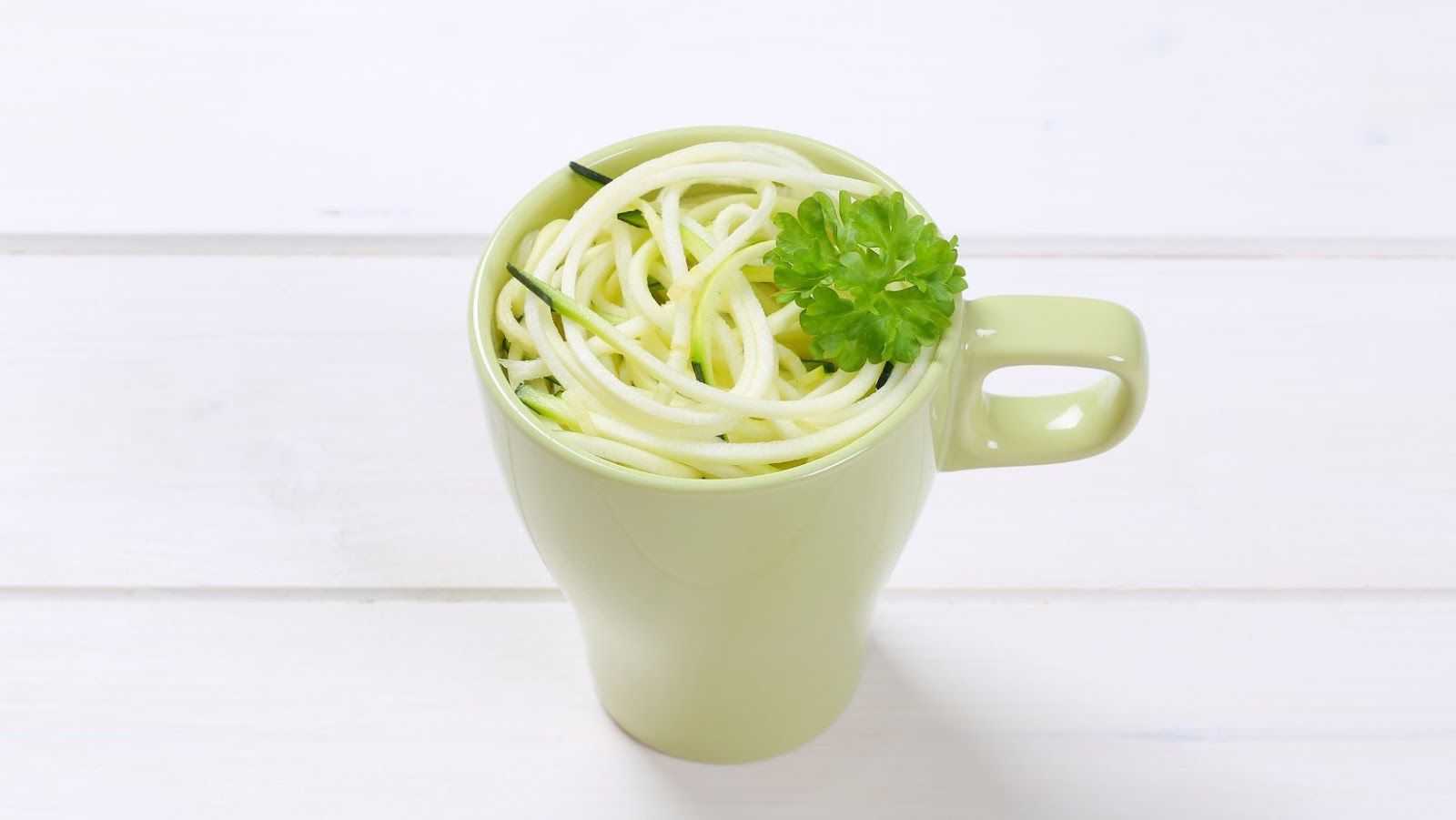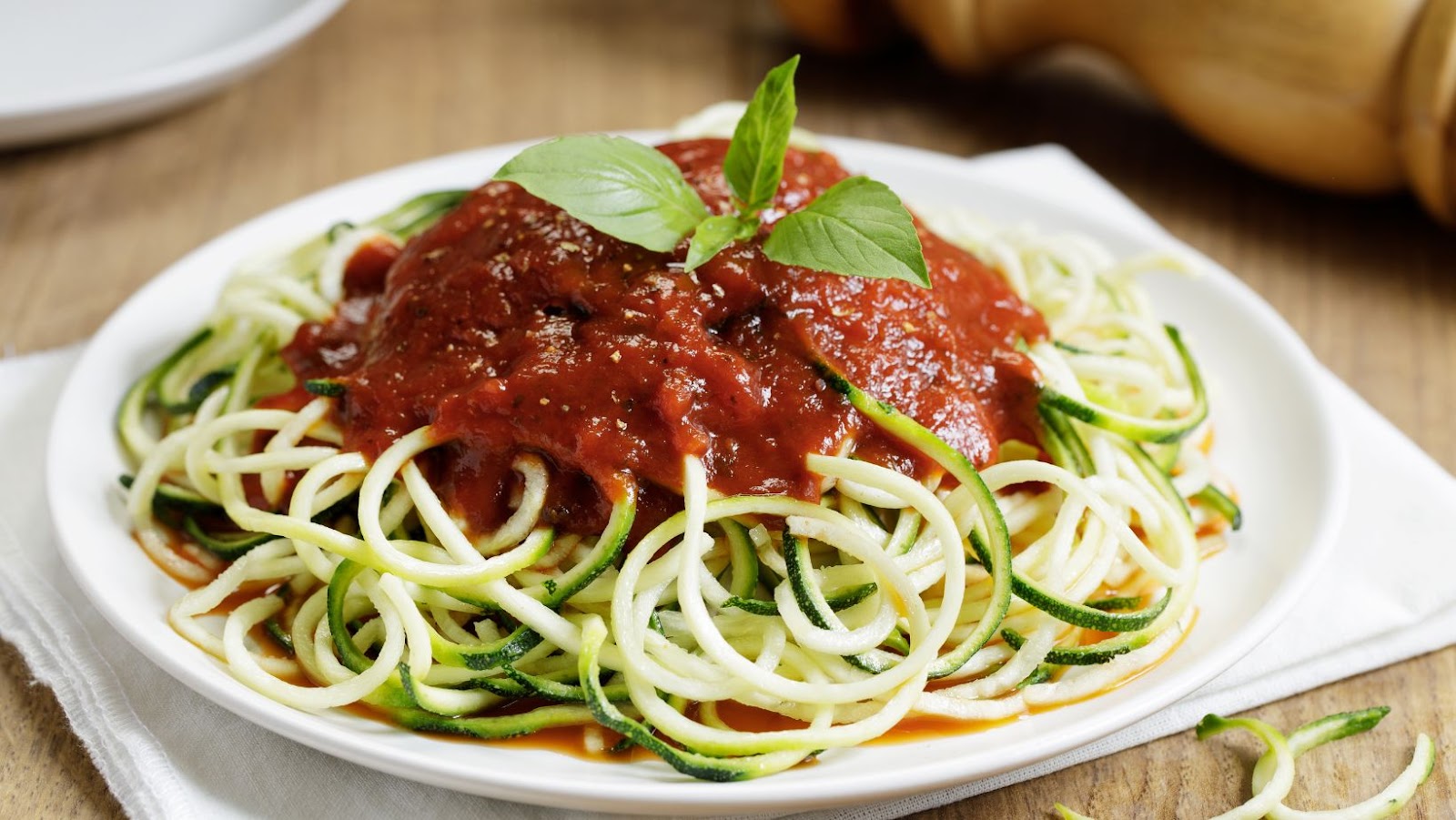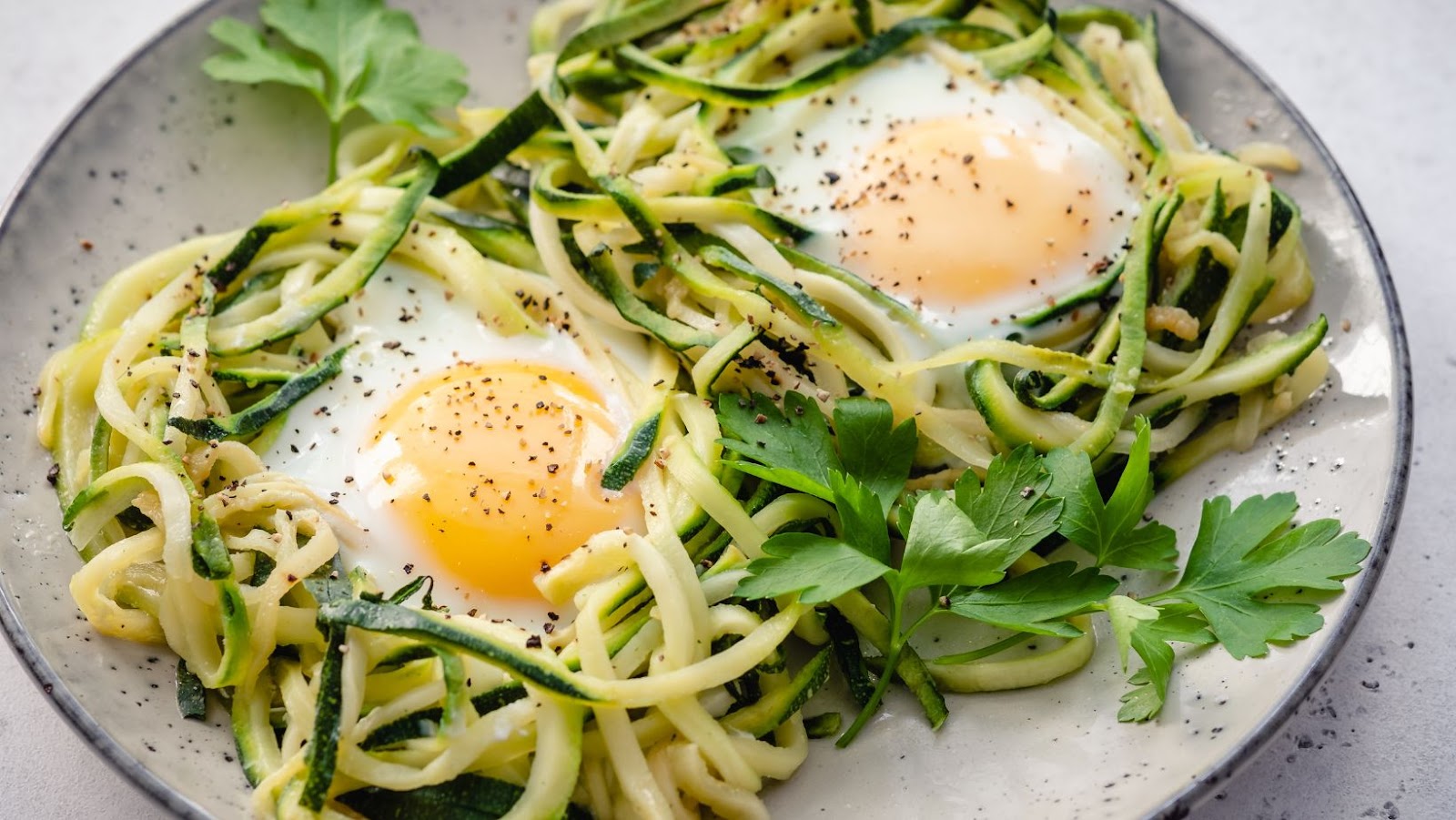
Enjoy Your Zucchini Noodles!
To make zucchini noodles without a spiralizer, try these three solutions: using a peeler, a mandoline slicer, or a knife. Peeling your zucchinis into thin, noodle-like strips is an easy option that doesn’t require any specialized kitchen gadgets. If you have a mandoline slicer, it can make creating your zucchini noodles quicker and more uniform. Using a knife is also a good option, but requires a bit more practice to get the thickness and shape just right.
Using a Peeler to Create Zucchini Noodles
Zucchini noodles can be made without a spiralizer by using a peeler. Follow these 5 simple steps to create long ribbons of zucchini that are perfect for salads or pasta dishes.
- Wash the zucchini and cut off the stem and blossom ends.
- Hold the zucchini lengthwise with one hand and use the peeler in your other hand to make thin slices along the entire length of the vegetable.
- Continue peeling the zucchini until you reach the seeds in the middle. Then, turn it over and repeat on the other side.
- Stack several slices of zucchini on top of each other, then use your knife to cut them into thin strips like fettuccine noodles.
- Use immediately or store in an airtight container in your fridge for up to 3 days.
To make sure that your zucchini noodles remain fresh, don’t salt them as this will draw out moisture and make them soggy. You can also try sauteing them for a minute or two in some olive oil before serving.
If you’re looking for a low-carb alternative to traditional pasta, try using zucchini noodles instead. They have fewer calories, less fat, and more nutrients than regular pasta. Don’t miss out on this healthy and delicious option!
Why bother with a spiralizer when you can slice and dice your way to zucchini noodle perfection with a mandoline?
Using a Mandoline Slicer to Create Zucchini Noodles
Slicing Zucchini into Noodles with Mandolin Slicer
Using a mandoline slicer is a great way to make zucchini noodles for everyone who does not have a spiralizer machine. It saves time and makes thin and consistent strands.
3-Step Guide to create zucchini noodles:
- Begin by washing your zucchinis and trimming the ends.
- Adjust the mandoline slicer’s thickness to the desired size, usually about 1/8 inch, to get long and thin noodles.
- In a back-and-forth motion, run the zucchini over the mandoline slicer blades until you reach the end of each piece.
For an appealing texture or color variation, try using colored zucchinis or draw a fork down each noodle lengthwise before boiling. In addition, be careful when using this sharp tool. You may want to wear cut resistant gloves or stop before reaching the end of each piece if you are concerned about your fingers getting too close to the blade.
If you don’t plan on cooking your noodles right away, it’s best practice to store them in a paper towel-lined container within your refrigerator for up to three days. To add flavor and enhance the taste of your dish, consider tossing cooked zucchini noodles in olive oil, minced garlic, diced tomatoes, salt & pepper or serving them as low-carb pasta alternatives with spaghetti sauce.
Who needs a spiralizer when you have a knife? Just think of it as a workout for your arms and a potential trip to the emergency room.
Using a Knife to Create Zucchini Noodles
Zucchini can be easily turned into noodle-like strands using a sharp knife.
To create zucchini noodles using a knife:
- Begin by cutting off the ends of the zucchini and discarding them.
- Use a mandoline or a sharp knife to create thin, even strips lengthwise down the zucchini, stopping when you reach the seedy core.
- Stack these strips on top of each other and use your knife to slice them into thin strands.
It’s essential to have a steady hand while using a knife to make zucchini noodles and keep them all around the same size for even cooking.
Fun Fact: The first spiralizer was patented in 1990 in Japan, but it wasn’t until its introduction to Western cuisine that it gained popularity as a kitchen gadget for creating vegetable noodles.
Get ready to have a noodle-tastic time in the kitchen, without the need for a spiralizer!
How to Make Zucchini Noodles Without Spiralizer
To cook your zucchini noodles without a spiralizer, this section offers you useful tips for boiling, sautéing, and baking them. By following these simple methods, you can prepare zucchini noodles with ease and enjoy their delicious taste and texture in your favorite dishes.
Boiling Zucchini Noodles
Cooking Zucchini noodles can be done by boiling them gently in water. This process ensures that the noodles are cooked to perfection without becoming mushy or losing their texture. To boil zucchini noodles, follow these steps:
- Fill a large pot with enough water to fully submerge the zucchini noodles.
- Place the pot on high heat and bring the water to a rolling boil.
- Add salt to boiling water for extra taste.
- Gently add the zucchini noodles into the boiling water and let them cook for 1-2 minutes.
- Using tongs or a strainer, remove the zucchini noodles from the boiling water and place them in a colander to drain excess water.
It is important not to overcook zucchini noodles as they will become mushy and bland in taste. Furthermore, it is also recommended to rinse them in cold water after draining so that they stop cooking.
Did you know that Zucchini belongs to the same family as cucumbers? They were first introduced into America during World War II but were primarily grown for their ornamental characteristics until recently where they gained popularity due to their health benefits and versatility in cooking methods such as boiling, sautéing, or even baking!
If you thought zucchini noodles couldn’t get any healthier, wait till you see them sautéed with just a touch of oil and a sprinkle of guilt-free satisfaction.
Sautéing Zucchini Noodles
This section aims to provide instructions on how to prepare zucchini noodles via sautéing. This method involves cooking the shredded zucchini in a pan with oil until they become soft and tender.
Here is a simple 3-step guide to sautéing zucchini noodles:
- Heat some oil in a non-stick pan over medium heat.
- Add the zucchini noodles and cook for 2-3 minutes, stirring occasionally.
- Remove from heat once the zucchini noodles are tender and season with salt and pepper as desired.
When preparing zucchini noodles, it’s important to remove excess water by patting them dry before using them in any recipe. This step helps prevent the noodles from becoming mushy when cooked.
Pro Tip: Sautéed zucchini noodles make a delicious low-carb alternative to traditional pasta, and can be customized with various spices and seasonings for added flavor.
Who needs carbs when you can have guilt-free zucchini noodles? Bake them to perfection and impress even the pickiest of eaters.
Baking Zucchini Noodles
Zucchini noodles are a delicious and healthy alternative to traditional pasta. If you’re looking for a way to bake your zucchini noodles, these steps will guide you through the process:
- Preheat your oven to 375°F.
- Spread the zucchini noodles evenly on a baking sheet.
- Drizzle olive oil over the noodles and sprinkle with salt and pepper.
- Toss the noodles gently to coat them in the seasoning.
- Bake in the oven for 10-15 minutes, until the edges are slightly browned.
- Serve immediately or store in an airtight container in the refrigerator.
To add some variation, you can try adding chopped garlic or grated Parmesan cheese before baking. Baked zucchini noodles are great as a side dish or as a base for your favorite pasta sauce. They’re also perfect on their own as a light and healthy meal.
Don’t miss out on the opportunity to try this easy and delicious recipe! Baked zucchini noodles make for a fantastic addition to any meal, and are sure to impress your guests or family members alike. Give this recipe a try today! Who needs a fork and knife when you have a pair of chopsticks and a healthy dose of determination to conquer those slippery zucchini noodles?
Serving Zucchini Noodles
To serve your zucchini noodles with maximum flavor, you need to add a variety of sauces and mix-ins that complement the dish. In order to add a little twist to your noodles, you can mix vegetables with your zucchini noodles, or even incorporate protein. This section will explore the following sub-sections: Adding sauces to zucchini noodles, Mixing vegetables with zucchini noodles, and Incorporating protein with zucchini noodles.
Adding Sauces to Zucchini Noodles
Zest up your zucchini noodles by lathering them with lip-smacking sauces. There are many possibilities to explore!
- Try a classic marinara sauce for a rich and savory flavor.
- For an Asian twist, toss zucchini noodles with soy sauce, sesame oil and ginger.
- Add some spice with a tangy salsa or chili sauce.
- Elevate your pesto game by swapping traditional pasta for zucchini noodles
- Dress it up with a creamy alfredo sauce to indulge in comfort food.
- No-cook tomato basil sauce is perfect for hot summer days that doesn’t even require turning on the stove!
Take note of the texture and thickness of each sauce to determine which one complements your dish’s taste best.
Squash those cravings and try experimenting with different flavors to mold new favorites. Who needs a salad when you can mix all your veggies together with zucchini noodles and call it a day (or a meal)?
Mixing Vegetables With Zucchini Noodles
Mixing Different Vegetables with Zucchini Noodles
Zucchini noodles, or “zoodles,” are a low-carb and nutritious alternative to traditional pasta. One of the best things about zoodles is their versatility; they can be paired with a wide variety of vegetables to make different dishes that are both healthy and flavorful. Here are some ways you can mix different vegetables with zucchini noodles to create delicious meals:
- Add sautéed mushrooms, bell peppers, and onions for a savory and hearty meal.
- Mix sliced cherry tomatoes, baby spinach, and fresh basil leaves for a light yet flavorful salad-like dish.
- Pair diced eggplant and zucchini squash with zoodles to create an Italian-inspired dish.
- Toss roasted sweet potatoes, Brussels sprouts, and carrots with zoodles for a filling autumnal meal.
- Combine shredded carrots, red cabbage, green onions, and cashew nuts for an Asian-inspired slaw.
In addition to being delicious and easy to prepare, mixing vegetables with zucchini noodles also allows for an increased variety of nutrients in your diet. For example, incorporating sautéed kale or chopped broccoli florets will provide additional fiber while also increasing the amount of vitamins A and C in your meal.
To add even more flavors to your dishes try experimenting with different herbs like thyme or rosemary. You could also use flavorful sauces like tomato sauce or pesto for more depth. Whatever you decide to mix together, make sure you’re choosing fresh ingredients for optimal taste!
Who needs meat when you can load up on protein with these zucchini noodles, making it easy to fake being a health nut.
Incorporating Protein With Zucchini Noodles
To add protein to your zucchini noodles, there are a variety of options available. Here are six ways to incorporate protein with zucchini noodles:
- Shredded chicken or turkey
- Grilled tofu or tempeh
- Sautéed shrimp or scallops
- Pan-seared salmon or tuna
- Baked beans or chickpeas
- Nutritional yeast or grated Parmesan cheese
Incorporating protein with zucchini noodles adds a nutritional boost while keeping the meal light and refreshing. Additionally, these options can be easily customized to suit different dietary preferences and restrictions. To further enhance the flavor and texture of your zucchini noodle dish, consider using homemade sauces or seasonings like garlic, basil, lemon juice, olive oil, and balsamic vinegar. This will ensure a delicious meal that is also packed with health benefits.
By incorporating protein-rich foods into your zucchini noodle dishes, you can create a balanced and satisfying meal that keeps you full for longer periods. Experimentation with various combinations will allow you to find the best-tasting ways to enjoy this healthy dish without compromising on taste. Zucchini noodles may have a short shelf life, but that won’t stop me from pretending I’m a healthy chef for at least a week.
Storage and Shelf Life of Zucchini Noodles
To ensure the longevity of your delicious zucchini noodles, learn how to properly store them. With the right techniques, you can have a supply ready to go whenever you want to whip up a quick meal. Keep reading to discover the best practices for proper storage of zucchini noodles, including their refrigeration and freezing.
Proper Storage of Zucchini Noodles
Zucchini noodles require proper storage to maintain their quality and freshness. To prevent dehydration, mold formation, and spoilage, store the zucchini noodles in an airtight container or bag in the refrigerator at or below 40°F. Ensure that the noodles are dry before storing them to prevent excess moisture that leads to spoilage.
To extend their shelf life, avoid washing the zucchini noodles until you are ready to use them. This will prevent excess moisture retention in the noodles, leading to mold growth or rotting. Zucchini noodles can last in the fridge for up to five days if stored appropriately. It is essential to avoid keeping cooked zucchini noodles with raw vegetables to stop cross-contamination and limit bacterial growth. When reheating cooked zucchini noodles, ensure that it reaches an internal temperature of 165°F for food safety purposes.
To enjoy fresh-tasting zucchini noodles throughout their shelf life, keep them away from direct sunlight and heat sources because they accelerate spoilage. Additionally, rotate your stock regularly so that you consume older noodle batches first.
Proper storage of zucchini noodles involves safely storing them at or below 40°F and monitoring their temperatures throughout their shelf life consistently. As such, with proper storage techniques and adherence to food safety measures, one can get maximum taste out of these healthy vegetables.
Keep your zucchini noodles cool as a cucumber with these refrigeration and freezing tips.
Refrigeration and Freezing of Zucchini Noodles
Zucchini noodles can last for a certain period if stored properly. To extend their shelf life, refrigeration and freezing of zucchini noodles are two options that work well.
Here’s a 5-step guide to storing and extending the shelf life of zucchini noodles:
- Refrigerate freshly made or purchased zucchini noodles immediately in an airtight container.
- Consume refrigerated zucchini noodles within 3-4 days, as they tend to wilt over time.
- To freeze the zucchini noodles, first blanch them in boiling water for 1-2 minutes, then rinse with cool water. Drain off all excess moisture before packaging.
- Place the blanched and cooled noodles into freezer-safe bags with as little air as possible. Label the bags with the date.
- Zucchini noodles frozen this way can last up to a year in a deep freezer and six months in a normal freezer.
It’s worth noting that thawing frozen zucchini noodles takes some time. Place the frozen bag of zucchini noodles into the refrigerator for several hours before attempting to cook. Before cooking or consuming zucchini noodles, inspect them closely to ensure they haven’t gone bad. The presence of mold or unpleasant smells indicates spoilage.
To preserve freshness further, it’s best not to toss cooked zoodles into sauce until serving time. This ensures that they remain crisp and maintain their texture. Overall, by following these simple steps on storage and shelf life of zucchini noodles, you can keep your dish fresher for longer periods.
Zucchini noodles are the perfect guilt-free way to enjoy pasta, unless you’re like me and drown them in Alfredo sauce.
The Benefits of Zucchini Noodles
To fully embrace all the benefits of zucchini noodles, implementing them in your diet is a great start. Incorporating them can provide a range of health benefits such as fiber, vitamins, and antioxidants, amongst others. In order to cater to dietary restrictions or preferences, the article will also provide alternative options for zucchini noodles.
Health Benefits of Zucchini Noodles
Zucchini noodles are a healthy alternative to traditional pasta and can provide various health benefits.
- Low in Calories: Zucchini noodles are low in calories, making them ideal for weight loss and management.
- Rich in Nutrients: They are packed with essential nutrients such as folate, vitamin C, and potassium.
- Gluten-Free and Low Carb: Zoodles are an excellent option for those on a gluten-free or low-carb diet.
- Improved Digestion: Zucchini contains soluble and insoluble fiber that helps regulate digestion and prevent constipation.
Moreover, zucchini noodles can also be easily prepared through spiralizing the vegetable into long strands and cooked like regular noodles. Hence they allow for versatility in cooking.
For added benefits of zucchini noodles, try incorporating them into salad recipes or mixing them with other vegetables to maximize their nutritional value. To enhance their flavor, sprinkle some parmesan cheese or toss them with pesto sauce. These small modifications will add unique flavors while providing the health benefits of these naturally nutrient-rich vegetables.
If you’re on a low-carb diet and missing pasta, zucchini noodles are here to save the day and make your taste buds sing.
Dietary Restrictions and Zucchini Noodles Alternatives
For individuals with dietary restrictions, finding zucchini noodles alternatives can open up new possibilities of meal planning or discovering new dishes. Here are some options for people with specific dietary requirements to enjoy similar benefits as those achieved by consuming zucchini noodles.
- For gluten-free eaters: spiralized sweet potatoes, cabbage, or carrots provide a similar texture and can be enjoyed in various dishes.
- For low-carb eaters: spiralized vegetables like cucumber, daikon radish, or kohlrabi are great substitutes to consume fewer carbs without sacrificing flavor.
- For paleo eaters: spaghetti squash can replace zucchini noodles in most meals and offer additional nutrients like vitamin C and potassium.
- For keto eaters: shirataki noodles are a popular alternative to traditional pasta that can be substituted for zucchini noodles.
- For vegan eaters: using spiralized beets or turnips as a substitute is an excellent option, especially when used in stir-fries or salads.
- For raw food enthusiasts: spiralizing zucchinis, carrots, and even jicama offers endless possibilities for raw dishes.
It’s essential to note that the nutritional values may differ from person to person and depending on preparation method. It’s advised to consult with a physician before making significant changes in diet plans.
Zucchinis weren’t always a famous ingredient used for creating veggie noodles. In fact, it wasn’t until the invention of the spiralizer machine in Japan that made it more accessible for home cooks worldwide to create such dishes at home. Since then, it has been trendy among many health enthusiasts looking for lower-carb substitutions.
Who needs pasta when you can spiralize your way to health and happiness with zucchini noodles?








